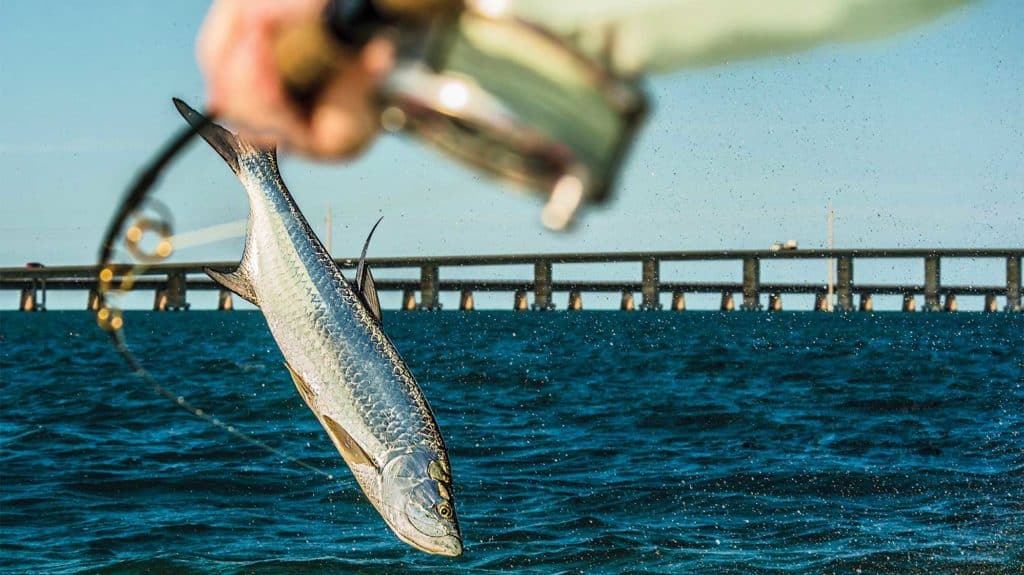
When the tarpon run is on, anglers from all around the globe flock to Florida to tangle with the incomparable silver king. The best locations, strategies and times to catch tarpon in Florida vary according to the region, but a group of expert tarpon chasers from both coasts of the Sunshine State share proven secrets to help shorten your path to success with live bait, lures and flies.
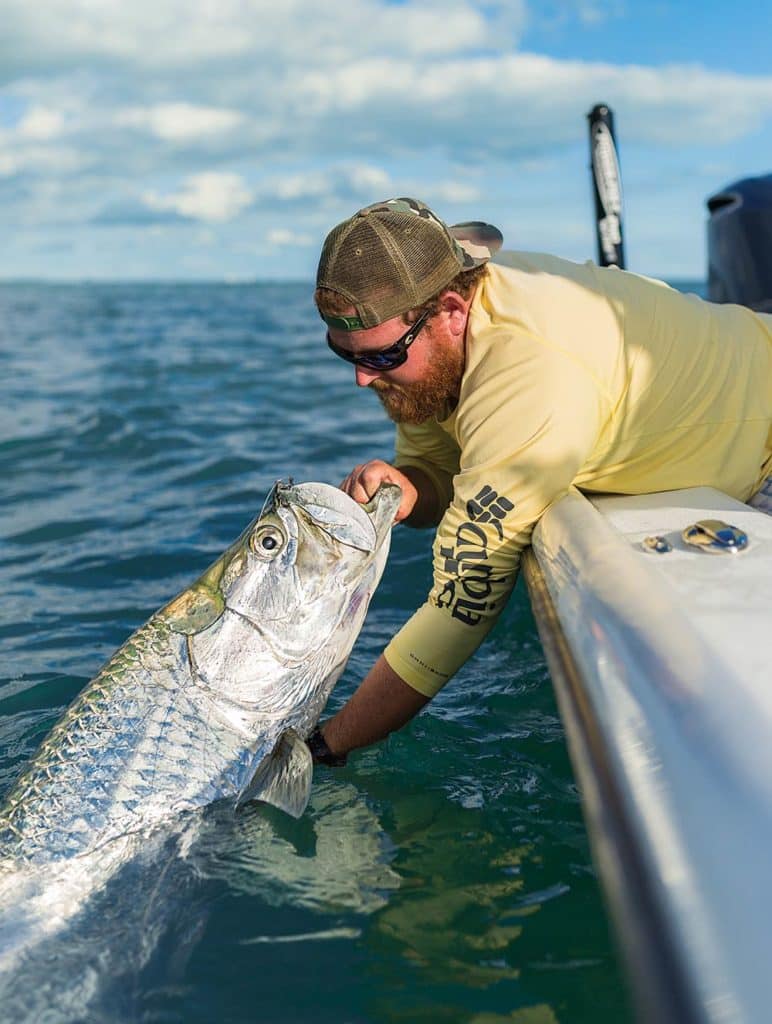
Tarpon Fishing on the East Coast of Florida
During the full moons from late April through June, large populations of tarpon that have been wintering in Miami begin migrating back and forth between Government Cut and Islamorada in the Florida Keys. Capt. Bouncer Smith explains that these oceanside fish spawn around those moons, on out to 20 miles.
“One day we may see a bunch of tarpon south of Bear Cut, and the next day we may not see any until we’ve traveled south almost to Key Largo,” he says.
Once spawned, the tarpon begin migrating north. Those which haven’t spawned continue moving between Miami and Islamorada until they do. This is prime time for fly-fishing and casting lures such as topwater plugs, soft plastics, and jig-and-worm combinations. Live crabs or silver mullet headline the live-bait selections.
Come April and May, between Haulover Inlet in North Miami and Hillsboro Inlet at Pompano Beach, Jeff Maggio explains, “That’s the time we let the tarpon come to us.
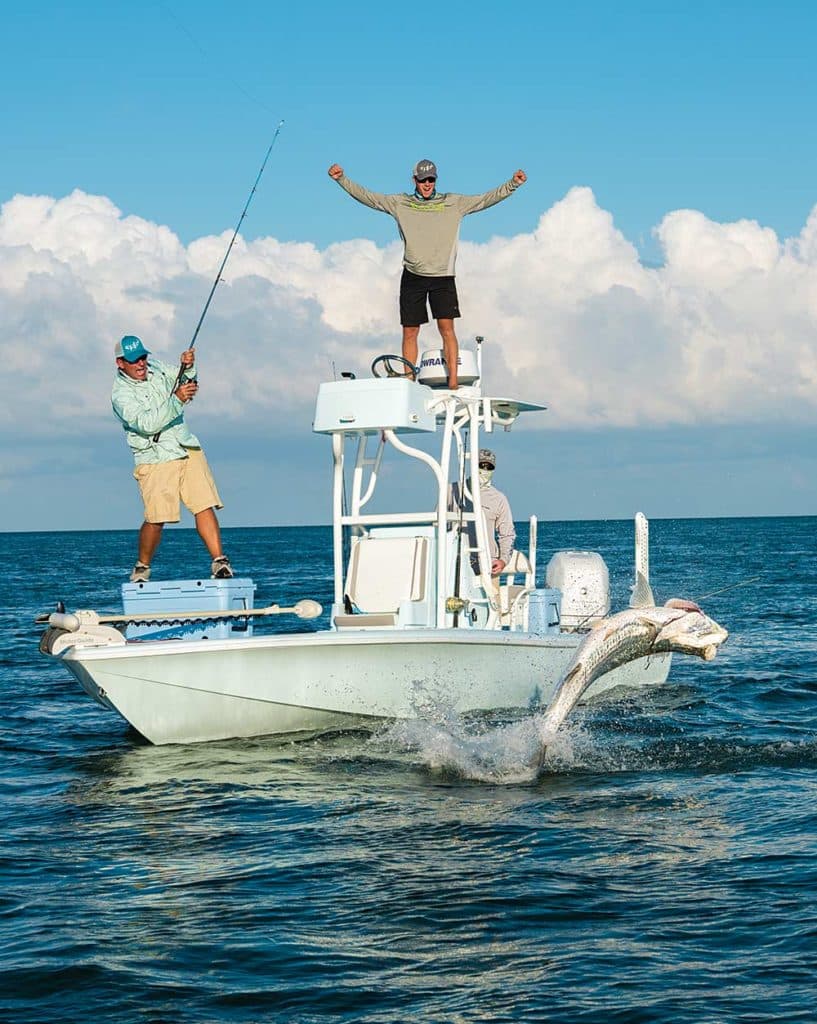
“The fish we’re seeing then are the ones migrating north from the Keys, and we also have inshore tarpon heading out to the ocean. We’ll set up by either the inlet jetties or Intracoastal Waterway bridges and wait for a push of fish to come our way.”
Maggio says the fish are switching from primarily feeding on shrimp to finfish such as mullet, pilchards and pinfish. If you’re impatient and don’t want to wait on the fish to come to you, he suggests slow-trolling live mullet or large pilchards — or even swimming plugs — along the beaches. “They’ll be coming through, and you’ll eventually encounter them.”
Up by Stuart, Capt. Chris Britton is scouring the beaches from the St. Lucie Inlet south for northbound migrating tarpon during April and May. “We’ll run south and along the beaches to intercept these fish,” says Britton. “There could be two fish or there could be 200 of them in a school. It’s pretty much the same situation north of here too. My go-to baits are live mullet and blue crabs. My best lure is a 10-inch original Hogy in white, black or bubble gum.” With live baits and lures, Britton says it’s imperative to pull them on a 45-degree angle across the path of the migrating tarpon for the best response.
Around Port Canaveral and south to Sebastian, it’s more of the northbound intercepting game. Capt. Scott Lum says to run the beach from the port south to Sebastian and look for pogy (menhaden) schools. “The fish will likely be tight to the beach and feeding on these baits pods, or they could be in that 30- to 40-foot range,” he says.
Also, Lum says when the tarpon reach Port Canaveral, sometimes they’ll hang there for a bit before moving north. This is because of the vast amount of bait that gets trapped around the cape. “Match the hatch and cast live pogies to them,” says Lum.
His favorite lures are a Hogy Pro Tail and soft swimbaits reeled steadily across and in front of tarpon. —George Poveromo
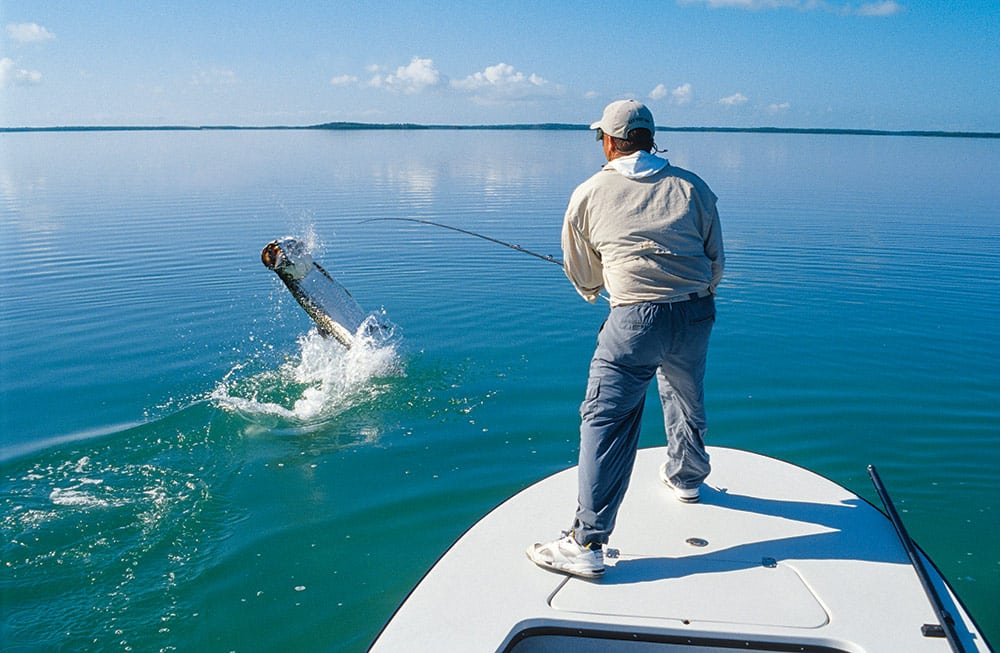
Florida Keys
In tarpon fishing, the Florida Keys and Florida Bay represent the crown jewels, unmatched in abundance and variety.
In February, when water temperatures scratch the mid-70s, migrating fish move out of the Gulf and poke their noses into the channels and onto the banks in Florida Bay and into the Marquesas, west of Key West.
The same pattern strengthens through March, and by April, they are reliably in the Florida Bay backcountry. At the same time, fish are moving out of Government Cut and Haulover Inlet to the north, and cruising down the east coast, past Elliott Key, Key Largo, then Islamorada and the middle Keys.
Prime Time
“April is my favorite time to fish the migration,” says Capt. Paul Tejera, who has been at this game for more than three decades. “I used to like May best, and it’s still good, but in April, the fish are fresh in the shallows and they are more willing to eat. They haven’t yet come across a lot of anglers casting at them.”
Tejera specializes in fly-fishing. “In Florida Bay, they like black-and-purple flies; on the ocean side, variations on chartreuse seem to work better,” he says.
The Keys are renowned for the quality of habitat suited to fly-fishing, and while locations such as Nine Mile Bank, Man O’ War Basin, Rabbit Key, Twin Keys, and the cuts and basins on the Gulf side of Key West still draw fly anglers from around the world, conventional and spinning tackle account for a tremendous amount of caught fish.
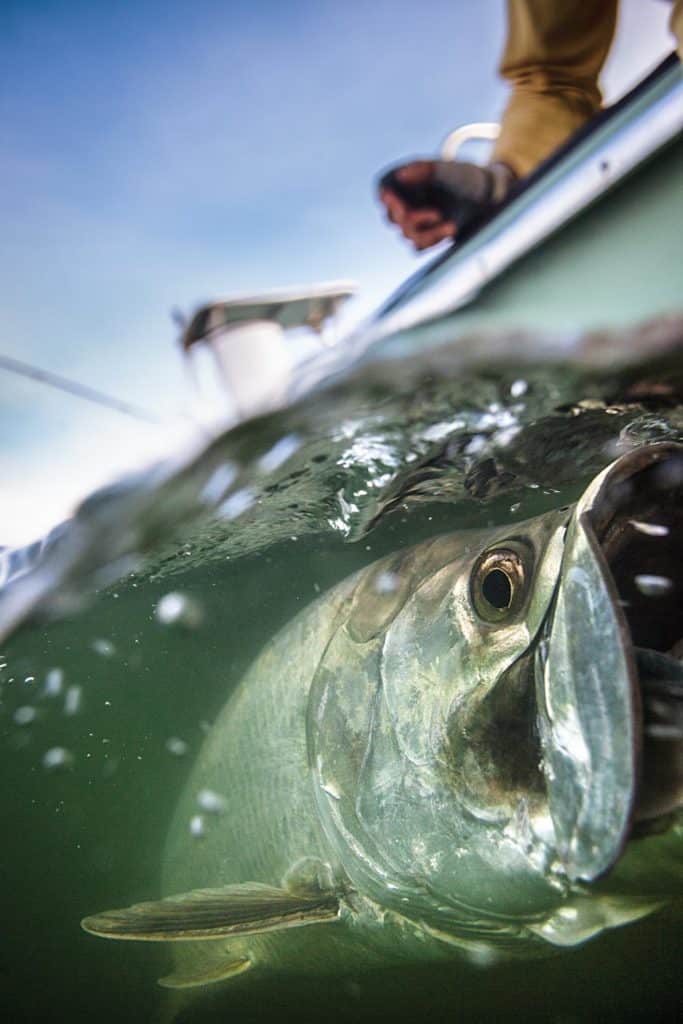
Willing Takers
Artificials, such as Slug-Gos, jigs and swimbaits, and live baits —crabs and large shrimp — remain just as tempting to tarpon cruising with the tide along the edges of flats and banks.
Most reliable, and a Keys mainstay, is fishing live baits beneath the bridges. Boats anchor in the channels and drift live mullet or crabs on conventional and spin outfits rigged with 50-pound braid and a cork float to suspend the bait in the flow, in front of the fish holding in the current. Many anglers’ first-ever tarpon has fallen to this strategy. Bridge action begins early in the tarpon fishing season and lasts well into July.
Sometime in May, around the full moon, the migrating fish change their pattern. With the appearance of the worm hatch — palolo worms that emerge from hard-coral bottom (especially well-known at Bahia Honda) on the right tide and moon phase — tarpon begin feeding in earnest, then reverse their course, taking an easterly, then a northward set on their migration.
By July and August, Tejera says, the bigger fish, averaging 90 pounds, with plenty of larger ones as well, have moved on, but smaller tarpon remain abundant from Islamorada through Key West. Late summer sees overall numbers dwindle, though a substantial number of resident fish, usually bigger specimens, remain in channels and cuts, while smaller fish hang out in backcountry basins. —SWS Staff
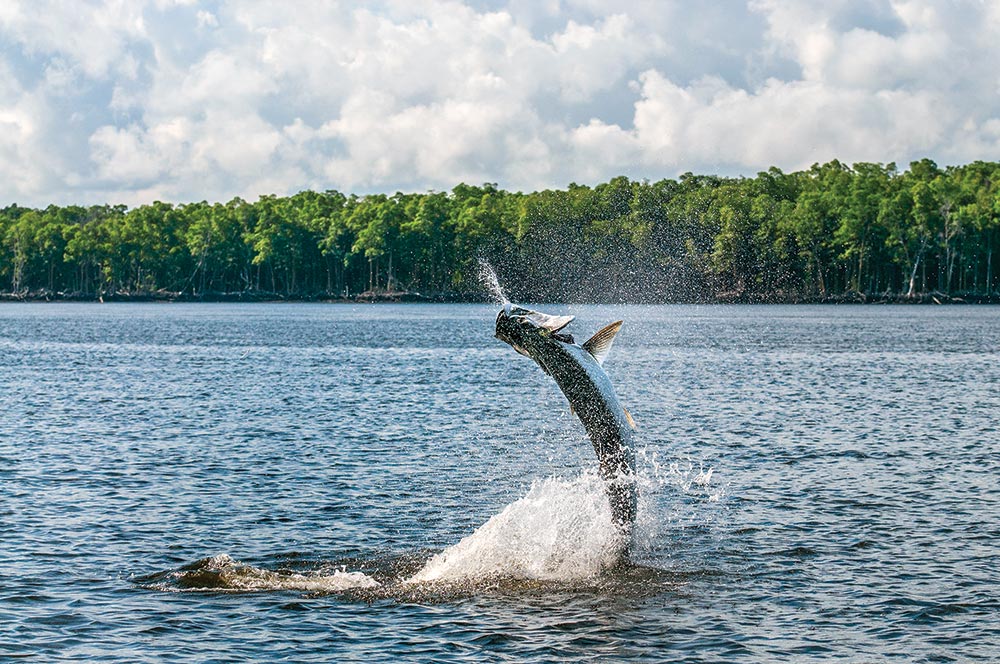
Ten Thousand Islands
Rising water temperature drives tarpon out of the Gulf of Mexico and onto Florida’s west coast by March, as early as February in some years.
“The magic number for us is 72 degrees,” says Capt. Ken Chambers, who guides the Ten Thousand Islands and Everglades National Park out of Goodland, Florida. “We see them first south of Chokoloskee.”
In the early part of the Florida tarpon fishing season, the fish come out of the Gulf in waves. The bays will fill up, then there will be another wave as they push through in big groups, spreading northward and filtering through the bays and the backcountry.
Once the big numbers of fish arrive, they spread out from Lostman’s River all the way up the coast, on the outside.
In general, this is the pattern for the entire migration, from mid-March through mid-June.
Early Shift
The biggest schools of moving fish are found 1 to 5 miles offshore, in less than 15 feet of water. On calm days, they’re easy to see, rolling on the surface.
The best strategy for these tarpon traveling down the Gulf Coast is to locate them, position the boat in their path, then wait for them to swim into casting range.
“Tarpon moving on the outside are hungry. They are the easiest ones to catch,” says Chambers, “especially early in the season with live baits, such as threadfin herring or sardines.”
These same fish are eager takers for lures also, when they are fresh in and haven’t seen a lot of boats yet. Chambers recommends soft-plastic baits like Zoom flukes and swimbaits, or ½-ounce bucktail jigs. DOA’s Bait Buster, in white or glow, or an assortment of different fly patterns work equally well.
“The first groups of fish you get on during the migration usually provide the best action due to lack of fishing pressure,” says Chambers.
Stealth
The preferred rig for the necessary gentle presentation on casting tackle is a 60-pound fluorocarbon leader and a 4/0 or 5/0 circle hook run horizontally through the nose of a weightless live bait or lure.
Chambers’ game plan: Go out early and look for clean water, signs of bait, and rolling tarpon in the channels and rivers. When it’s calm, look on the outside for schools moving north.
“My favorite fishing,” says Chambers, “is sight-casting on the shoals in May. Set up on a sandbar, over white bottom with the sun behind you, and let them run into you.
“Cape Romano Shoals makes an ideal setup spot. You can follow miles of shoals south and find fish all the way.” —SWS Staff
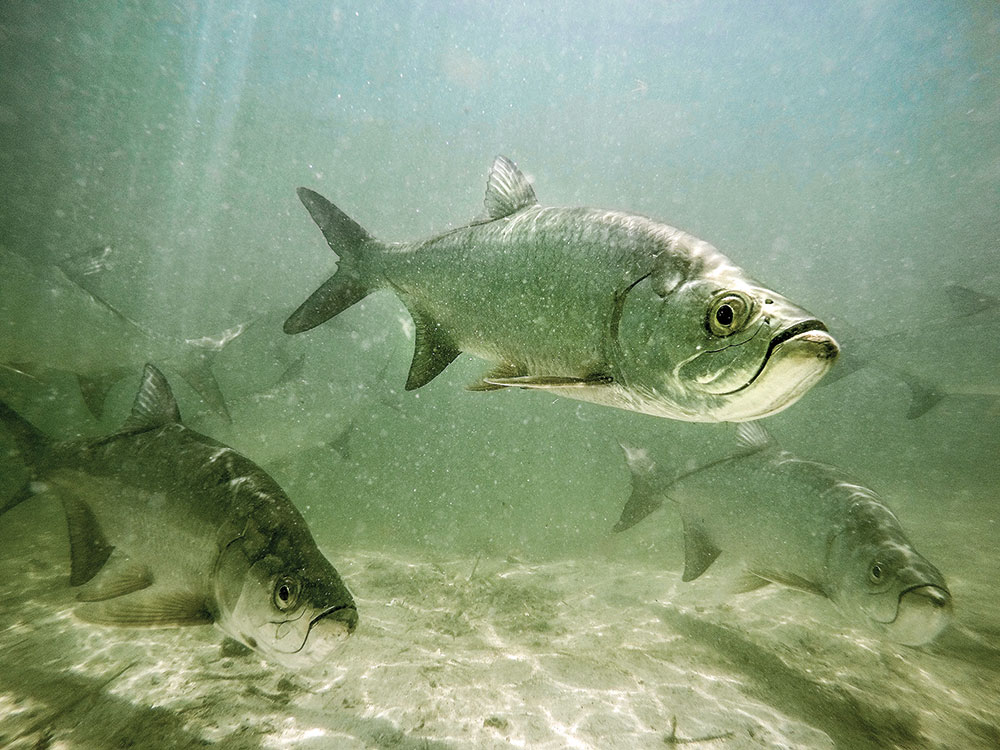
West Coast Tarpon Fishing
Blessed with a diverse tarpon-friendly habitat and multiple access points for anglers, from bays to beaches, rivers to passes, the region stretching from just above the Everglades to below Florida’s Big Bend delivers consistent opportunity to fish a range of styles.
Fort Myers
May brings the best action, but Capt. Chris Wittman expects the first of several waves of fish by late March, with action continuing through June. Fish the passes and adjacent beaches or shoals with live threadfin herring, menhaden or crabs. The latter are particularly effective when big moon tides pull crustaceans from inside waters. Casting or trolling lipped plugs along the Sanibel Causeway shadow lines also pays off.
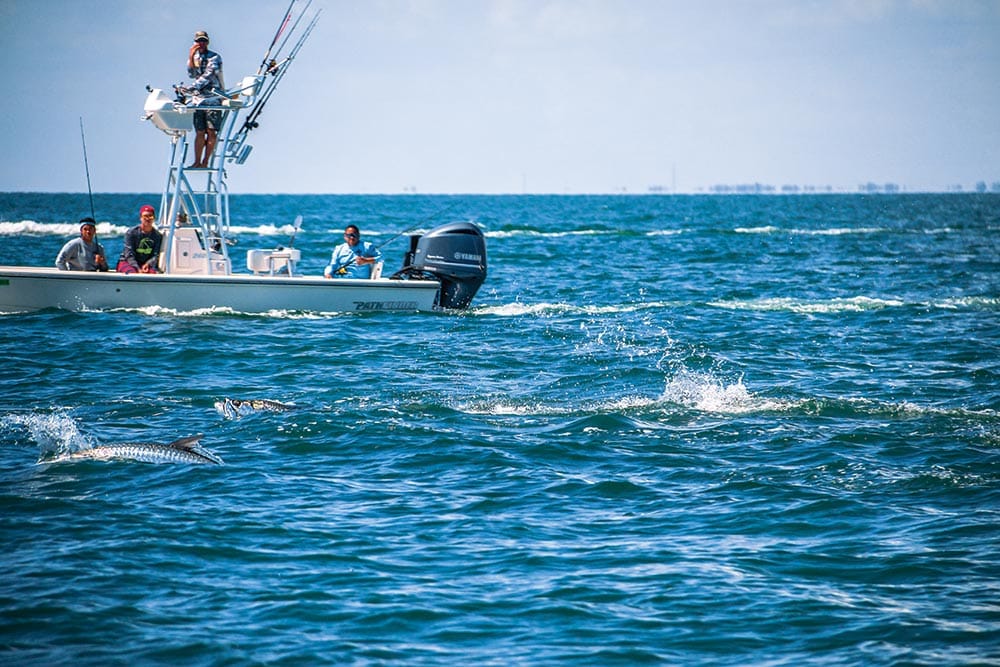
Boca Grande
This renowned pass between Cayo Costa and Gasparilla Island sees massive aggregations from April until July, with May and June prime. The fish favor the Lighthouse and Coast Guard holes, where they’re caught during full-moon “hill tides” with vertical jigs, free-lined crabs or slow- trolled pinfish.
Between periods of optimal conditions, Capt. Jeff Hagaman live-baits inside Charlotte Harbor, Pine Island Sound, and along the beaches.
Tampa Bay
May and June find tarpon packed around the Sunshine Skyway Bridge, where anglers anchor up-current and drift crabs, pinfish or threadfin herring past the pilings for tarpon waiting in the slack water. Capt. Billy Millers prefers idling the main channel from the bridge to Egmont Key, and corking crabs for tarpon spotted on sonar. Other options: Sight-casting live baits and swimbaits along beaches, and soaking chunks of mullet, menhaden or ladyfish around rocks or channel edges.
Anclote-Hudson
Waters north of Tampa Bay see less traffic but plenty of tarpon, especially on June’s full moon. Through July, Capt. William Burbach sight-casts crabs, threadfin herring or mullet along the beaches off Anclote Key and other barrier islands at daybreak. Later, drift the flats behind Anclote, as well as those of St. Joseph Sound and the Cotee River mouth with swimbaits and plastic jerkbaits on jig heads.
Homosassa-Crystal River
Peaking during May and June, the famous Oklahoma Flats between Bayport and Chassahowitzka, south of the Homosassa River, is where fly-fishermen patiently stalk giants.
North of the Homosassa River, anglers free-line or float crabs, pinfish or threadfins along current rips, while diving plugs and cut mullet produce inside the Homosassa and Crystal rivers. —David A. Brown
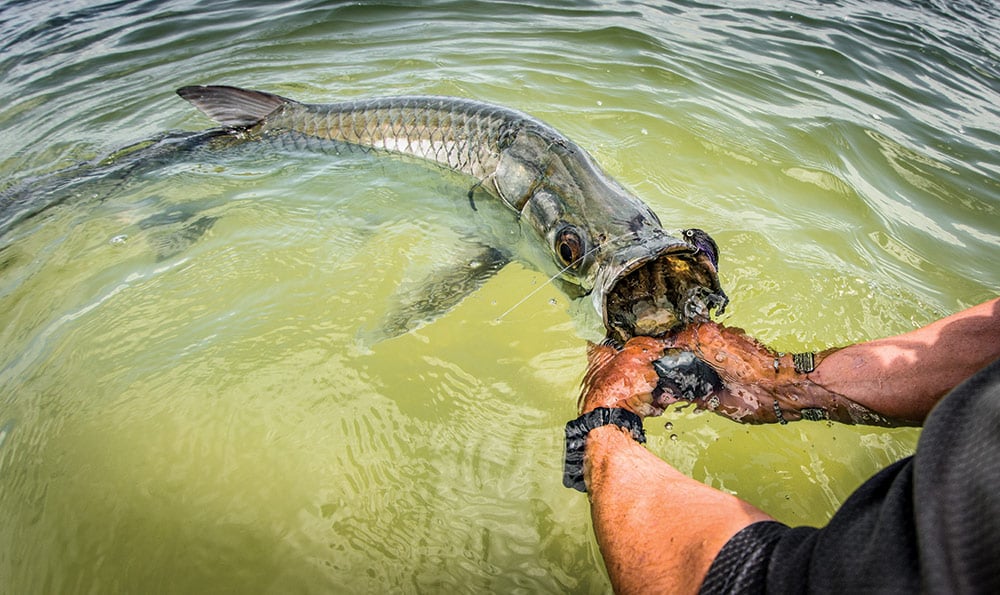
Big Bend
In Northwest Florida and the Panhandle, tarpon are seasonal visitors, appearing late in their migration. Here, June and July are the top months for anglers to intercept them.
When the fish move north along the Gulf coast of Florida, they veer seaward as they approach the Big Bend, cutting acrosss open water to the west, then moving back inshore near the Aucilla River and showing up again in Apalachee Bay. From that point westward, anglers hunt tarpon in well-established travel lanes and back bays as they continue migrating along the coast toward the Alabama border.
Fly anglers and other sight-casters position themselves in proven haunts and travel paths, and either stake out or anchor in shallow water to intercept the fish, which average 70 to 90 pounds, with a fair number weighing into the triple-digits.
Capt. Anthony Stone grew up in Homosassa and learned the intracasies of fishing the tarpon run before shifting his efforts to St. George Sound and Apalachee Bay in the early 1990s.
“I fish from the St. Marks River all the way to Cape San Blas and Crooked Island,” Stone says. “Spots that funnel the fish into narrower travel lanes are usually the best places to concentrate on. The ideal scenario is a midmorning high tide, right after the new or full moon, with moving water all day. That’s when the fish are most likely to eat.”
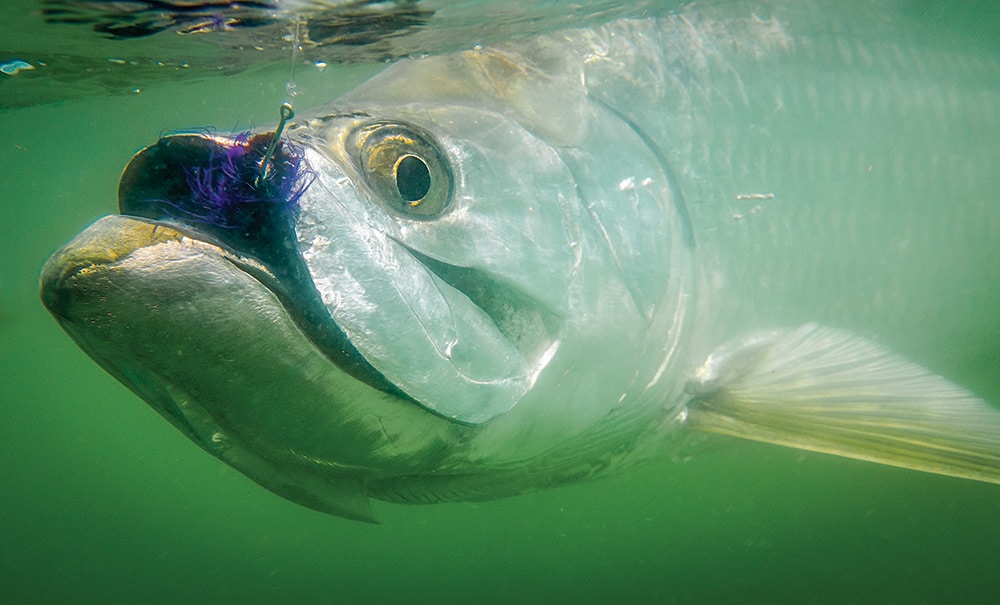
Stone arms his clients with 11- or 12-weight fly outfits loaded with a floating or sink-tip line, a tapered 9-foot leader, and 80-pound fluoro bite tippet. Floating crab patterns and streamers in light and dark color schemes, with chartreuse patterns as backups, fill his fly box.
Spin fishermen armed with a medium-heavy rod with a flexible tip, matched to a Penn 6000 reel loaded with 50-pound braid and 2 feet of 80-pound leader score with soft-plastic swimbaits such as a DOA Bait Buster in white-and-red or black-and-silver.
“Successful tarpon fishing is all about making the proper presentation,” says Stone. “Put that lure in the path of rolling fish and it’s rare for them to swim by without hammering it.”
“Calm winds and bright sunshine make it easier to spot fish,” says Capt. Pat Dineen, who targets tarpon off Destin beaches during the peak season. “We let them come to us in that clear water. The best time is from daylight until about 1 p.m., before the sea breeze kicks up and makes it difficult to see the tarpon.”
Dineen prefers live bait, with pilchards topping the menu. Cigar minnows, herring and alewives are also effective, along with dead mullet. He rigs each on 7/0 to 8/0 VMC circle hooks. For the fake variety, Hogy plastic eels hooked through the nose with a circle hook, or Storm swimbaits get the nod. Dineen uses 8-foot rods with 8000 series reels loaded with 30-pound braid tied to a 12-foot section of 50-pound fluorocarbon leader with an FG knot. —Dave Lear









